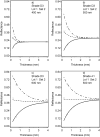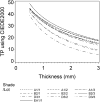Appearance Differences Between Lots and Brands of Similar Shade Designations of Dental Composite Resins
- PMID: 27622771
- PMCID: PMC5348282
- DOI: 10.1111/jerd.12263
Appearance Differences Between Lots and Brands of Similar Shade Designations of Dental Composite Resins
Abstract
Objectives: The purposes of this study were to investigate differences in two inherent appearance characteristics between lots of an enamel dental composite resin of the same shade and brand, and to further compare these differences to those of similar shade designation of a different brand of dental composite resins.
Methods: Appearance analyses proceeded for three different lots of shades A1, B2, and D3 manufactured by one company and for one lot of shade EA1 manufactured by another. Samples were measured on black, white, and gray backings using spectroradiometry. Kubelka-Munk theory was used to determine reflectivity of each lot studied. CIELAB values and color differences between shades and lots were analyzed. Translucency indicators were compared between lots over thicknesses from 0.5 to 3.0 mm.
Results: Differences in inherent color between some lots of same shade designations within a brand were found to be above the acceptability threshold. Color difference between an enamel composite resin of shade A1 and a composite resin of shade EA1 was also above the acceptability threshold. Statistically significant differences in the translucency were found between some lots of one shade over the entire range of thicknesses studied.
Conclusion: Appearance analyses indicate substantial variation between lots of same shade designations as well as between brands of similar shade designations.
Clinical significance: Optical principles applied to important clinical appearance attributes are described which characterize inherent appearance attributes and provide aid in the appearance matching process for dental composite resins used in restorative and operative dental procedures. (J Esthet Restor Dent 29:E6-E14, 2017).
© 2016 Wiley Periodicals, Inc.
Conflict of interest statement
The authors do not have any financial interest in the companies whose materials are included in this article.
Figures




References
-
- Sproull RC. Color matching in dentistry. Part III. Color control. Journal of Prosthetic Dentistry. 1974;31(2):146–54. - PubMed
-
- Schwabacher WB, Goodkind RJ. Three-dimensional color coordinates of natural teeth compared with three shade guides. Journal of Prosthetic Dentistry. 1990;64(4):425–31. - PubMed
-
- Kim BJ, Lee YK. Influence of the shade designation on the color difference between the same shade-designated resin composites by the brand. Dental Materials. 2009;25(9):1148–54. - PubMed
-
- Chu SJ, Trushkowsky RD, Paravina RD. Dental color matching instruments and systems. Review of clinical and research aspects. Journal of Dentistry. 2010;38(Suppl 2):e2–16. - PubMed
-
- da Costa J, Fox P, Ferracane J. Comparison of various resin composite shades and layering technique with a shade guide. Journal of Esthetic and Restorative Dentistry. 2010;22(2):114–24. - PubMed
MeSH terms
Substances
Grants and funding
LinkOut - more resources
Full Text Sources
Other Literature Sources

